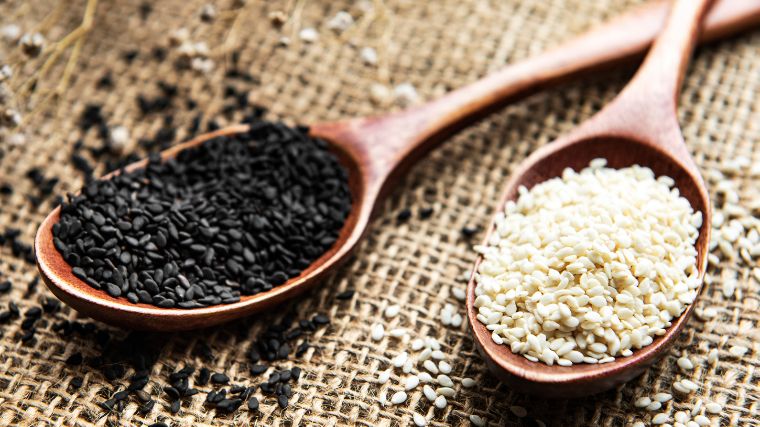There are plenty of essential minerals that humans need to maintain basic health and optimal functioning. But the one that most people can name from all those childhood commercials is calcium. That doesn’t render other minerals (think iron and zinc, for example) less important, but it does make some sense: calcium is the most abundant mineral present in the human body.
You’ve probably heard about the “building strong bones” appeal of milk (which is chock-full of calcium), but the mineral is also essential for transmitting neural impulses across your body. In other words, you need it to think, move, and — yes — deadlift 500 pounds.

All that said, you might know that you need calcium, but not where to get it. Because yes, not all of the best sources of calcium are milk-based, or even dairy-based. From plant-based eaters to omnivores, you’ll find a diversity of foods to get calcium from below.
What is Calcium?
If you’ve ever watched or listened to a single commercial sponsored by the American Dairy Association (or your favorite milk brand), you’re probably aware of calcium’s importance to bones and teeth. In this case, the advertising isn’t all hype.
Calcium is the most abundant mineral in your body by virtue of the fact that your skeleton is literally composed of collagen and calcium. Your body stores its ingested calcium in bones and teeth, contributing to their health and overall hardness.
[Read More: Nutrition for Athletes — How to Eat for Muscle and Performance]
Beyond its role in skeletal maintenance and improvement, calcium also functions as an electrolyte within your body. Calcium ions carry an electrical charge and play a major role in regulating several of your body’s physiological processes, including heart activity maintenance and muscle contraction. (1)
Benefits of Calcium
You may think you already have a satisfactory response lined up to answer the question of how calcium benefits your body, and you’ll probably at least be in the ballpark. Correct though you might be in at least one respect, your response will probably fall short in addressing the full scope of calcium’s importance. That’s because the mineral’s contributions to the maintenance of health are more diverse than most people initially realize.
Skeletal Health
Calcium contributes mightily to the strength and structure of bones. When combined with its close cousin phosphorus, calcium provides somewhere between 50 percent and 70 percent of your skeletal composition, with the remainder formed from protein and collagen. (2)
Calcium’s function here is to provide the bulk, thickness, and density to reinforce your bones and preserve your structural stability. That stability is definitely something you want on the lifting platform.

[Read More: The Complete Guide to Pre-Workout Supplements]
If your calcium intake is inadequate, your bones become less dense, and the structural integrity of your skeleton becomes compromised. This can result in eventual osteoporosis, which is marked by fragile, unstable bones and an increased risk of falling. Similar afflictions spawned by insufficient amounts of calcium are rickets and osteomalacia, which are both typified by soft, weak bones. (3)
Signal Transmission
With 99 percent of your body’s calcium resting in your bones, the remaining one percent of calcium is found within your blood, muscle, extracellular fluid, and other tissues. (4) Like all electrolytes, blood-based calcium plays a critical role in sending signals throughout your body. (5) This includes everything from near-automated movements like walking, to the very specific directions you give your muscles to clean & jerk a barbell into the air.
Calcium also helps to regulate involuntary muscle movements, like the beating of your heart. (6) As a result, a lack of calcium can reduce the strength, efficiency, and predictability of your cardiovascular system. (7)
[Read More: The Best Foods for Energy Before, During, and After Your Workouts]
Because of its role as a signal facilitator, calcium is also used in antacids. That’s because its carbonate form binds ions (which are used in signal transmission) and lowers your stomach’s pH level. (8)
How Much Calcium Do You Need?
Though the benefits of calcium aren’t really in dispute, the amount you need to consume daily is the subject of some debate.
The Food and Nutrition Board of the National Academies of Sciences, Engineering, and Medicine (FNB) states that all adults require between 1,000 and 1,300 milligrams of calcium daily. While these FNB figures are within the same basic ballpark, the bulk of the 300-milligram variance is determined by age, gender, and whether or not the individual in question is lactating. (3)
The recommended amount of daily calcium remains a far-from-settled issue. While the FNB figures are commonly cited, they are not the only calcium intake recommendations made by learned institutions. Outside of the United States, the National Health Service of Britain recommends a comparatively meager 700 milligrams per day. The World Health Organization’s calcium intake recommendation for non-pregnant people and men younger than 65 officially remains at 400 to 500 milligrams per day.

[Read More: The Definitive Guide to Bodybuilding Meal Prep]
Adding to the disagreement over the advisable level of calcium intake are the dissenting findings of calcium intake studies. One study conducted by the Women’s Health Initiative found no obvious reductions in the incidence of hip fractures in elderly study subjects who took high doses of calcium supplements.
This suggests that large quantities of calcium did not significantly increase bone density. (9) On the other hand, some studies have indicated that high calcium intake may lower the likelihood of cardiovascular disease. (10)
Can You Have Too Much Calcium?
The adage remains true that you can have too much of a good thing — and calcium is no exception. Hypercalcemia refers to a state in which the calcium level of your blood has reached a point where it is causing undesirable developments within your body. (11)
These problems can range from physical problems like gastrointestinal pains and fatigue to cognitive issues like depression and memory loss. Hypercalcemia can even worsen the very symptoms of osteoporosis that the calcium was often consumed to prevent. (11)
[Read More: The 16 Best Pre-Workout Supplements]
But if you prefer to have relatively high levels of calcium pouring into your body, you likely have little to fear from responsible supplementation. The Food and Nutrition Board has stated that tolerable upper intake levels for calcium are between 2,000 and 3,000 milligrams for most adults. (3) Even with supplementation, it would take considerable effort to routinely consume enough calcium to top that upper limit.
Best Sources of Calcium
Whether you’re a vegan or simply prefer a varied diet, it may come as a relief to you that calcium is present in many foods in at least trace amounts, including several meats and vegetables.

[Read More: The Best Healthy Fast Food Options at the Most Popular U.S. Chains]
And it’s not just in your veggies. An inspection of the labels of many snack foods would reveal that many varieties of cookies and chips often contain calcium as well. However, if you’re seeking greater intake efficiency, here are the calcium sources that will never leave you wondering whether or not you’ve satisfied your daily calcium quotient.
- Milk
- Cheddar Cheese
- Plain Whole Milk Yogurt
- Calcium-Fortified Orange Juice
- Sliced White Bread
- Kale
- Almonds
- Sesame Seeds
- Tofu
- Watercress
- Calcium Supplements
Note: Unless otherwise noted, all nutritional information is sourced from the USDA’s FoodData Central resource, and is rounded to the nearest whole number.
Milk
Provided that you don’t have a sensitivity to dairy products, milk is often the most readily available and easily located source of calcium. It’s certainly the most popular.

A single glass of milk in the morning is sufficient to fulfill about one-third of the FNB’s suggested daily calcium requirements and to the satisfaction of most institutional dietary guidelines.
- Serving Size: 8 oz
- Total Calcium: 309 mg
Cheddar Cheese
If you’re relying on cheese to satisfy your calcium needs, stick to hard cheeses like cheddar or Swiss. If hard cheese is unavailable or you can’t resist a good soft cheese, lean toward mozzarella over brie. Substituting brie for mozzarella instead can drop your calcium level by up to two-thirds.
- Serving Size: 2 slices (34 grams)
- Total Calcium: 240 mg
Plain Whole Milk Yogurt
The creamy goodness of yogurt isn’t only about probiotic benefits and protein allotment. Dairy-based yogurt (and some plant-based varieties, as well) often have high calcium levels.

[Read More: The 11 Best Supplements for Bodybuilding]
Though milk is the celebrated calcium queen, don’t sleep on yogurt. The concentrated dose of calcium contained in a cup of yogurt is noticeably greater than that offered by a glass of milk on a per-ounce basis.
- Serving Size: 1 cup
- Total Calcium: 190 mg
Calcium-Fortified Orange Juice
Though orange juice is not naturally high in calcium, many of these beverages are fortified with calcium. At an average grocery store or bodega, you can typically find fortified juices that deliver doses of calcium that easily equal the quantity served up by a glass of traditional milk.
- Serving Size: 1 cup
- Total Calcium: 349 mg*
*Information provided by MyFoodData
Sliced White Bread
Grocery store aisles are often saturated with calcium-enriched foods. This is particularly true on shelves that feature grain-derived products.
Bread and cereal have long had their calcium levels enhanced. By making a daily sandwich with two slices of Wonder Bread, you’ll be almost midway to your necessary calcium intake.
- Serving Size: 2 slices
- Total Calcium: 360 mg**
**Information provided by CarbManager
Kale
Be mindful that you’ll probably need to jettison the recommended serving sizes in order to get substantial calcium from most of your leafy vegetables. It’s true that they have high levels of calcium relative to their volume, but that’s only one part of the story.

[Read More: The 11 Best Fish Oils On the Market]
To paint a clear picture, if you’re purchasing spinach, kale, or turnip greens in 10-ounce containers, 100 grams of greens will typically amount to just over one-third of the entire container. If you want to use greens as a prominent source of calcium, you can’t be a nibbler.
- Serving Size: 100 grams
- Total Calcium: 254 mg
Almonds
While nuts are often categorically touted as a bountiful source of calcium, almonds are the true star of the group. As a point of comparison, it takes only 50 grams of almonds to ingest almost the same amount of calcium that is present in 150 grams of peanuts.
- Serving Size: 100 grams
- Total Calcium: 273 mg
Sesame Seeds
With nuts, it can be exhausting to chew through the quantity required to make a dent in your recommended calcium. Also, if you’re calorie-conscious, you’d have to consume 300 grams of raw peanuts — or more than 1,500 calories — to collect just 150 milligrams of calcium.

[Read More: The 8 Best Nitric Oxide Supplements]
Fortunately, if you’re looking for a calcium source of a similar texture but less chewing effort, a greater quantity of calcium is attainable through just 100 calories worth of sesame seeds.
- Serving Size: 2 tablespoons
- Total Calcium: 176 mg
Tofu
As a serviceable source of calcium that is easily consumed, it is very difficult to beat tofu. A very reasonable 100-gram serving of tofu has a level of calcium unrivaled by virtually all other practical serving sizes of most other food sources.
In fact, tofu rivals calcium supplements for overall saturation with the mineral, and puts most other entrée-caliber offerings to shame in this department.
- Serving Size: 100 grams
- Total Calcium: 683 mg
Watercress
On the basis of its calcium-to-calorie ratio, watercress is among the most calcium-dense foods on the planet. According to IntakeHealth, at nearly 11 milligrams per calorie, watercress has three times the calcium-density of skim milk.
[Read More: The 15 Best BCAA Supplements]
But it’s not all about caloric density. You also have to consider the sheer volume of food. Yet, in order to acquire the calcium content of a 12-ounce glass of nonfat milk, you’d have to eat nearly 300 grams of watercress. This is why you need to couple your knowledge of nutrition with the manner in which you’re actually prepared to eat your food.
- Serving Size: 100 grams
- Total Calcium: 120 mg
Calcium Supplements
When in doubt, you always have the option of securing much of the calcium you require from the supplement jar or bottle labeled “calcium.” Whether you opt to take it by the teaspoon or the capsule, one dose of each will usually bestow more than half of your daily calcium requirement upon you.

[Read More: The 9 Best Whey Isolate Protein Powders]
Just be careful not to get too heavy-handed with the supplement scoop, or you can inflate your calcium intake to uncomfortable levels that can result in intestinal discomfort.
- Serving Size: 1 softgel
- Total Calcium: 600 mg
Common Calcium Misconceptions
Owing to the straightforward way in which calcium is often presented to the general public, many people have an oversimplified understanding of exactly what it is and how it works. As with almost all digestible minerals that influence body chemistry, calcium is more complex than it appears at first glance. Let’s bust some calcium myths.
Misconception #1: All Calcium Is Created Equally
There are two primary sources of calcium that most people ingest — calcium citrate and calcium carbonate. Calcium carbonate is a chalky form of calcium taken in antacids, and it is used to relieve the symptoms of an upset stomach. This form of calcium is absorbed into your skeleton for the sake of its hardening properties.
On the other hand, calcium citrate has been shown to be absorbed into the human body far more readily. Therefore, if you’re forced to choose between forms of calcium for nutritional supplementation, calcium carbonate is best reserved to remedy any indigestion issues. (12)
Misconception #2: Calcium Is Fine in Isolation
Ingesting the required amount of calcium you need is one thing, but ensuring that your body actually absorbs the bulk of it is something else entirely. In order for you to be assured that curation of your meal plan doesn’t go to waste, you’ll need to get the requisite vitamin D. This is because vitamin D is transformed into calcitriol in your kidneys, and calcitriol is physically necessary for the efficient absorption of calcium into your system. (13)

[Read More: The 5 Best Krill Oil Supplements]
Without it, your rate of intestinal calcium absorption is likely to be cut in half. Fortunately, 10 minutes of sun exposure is usually sufficient to fill your daily vitamin D quota. (14) And when you’re taking a calcium supplement, you can check to ensure that it also comes with a boost of D vitamins.
Misconception #3: Calcium Only Comes From Dairy
As a remnant from milk commercials, you might get the impression that dairy products are the only sources of calcium present on the planet. This couldn’t be further from the truth.
Calcium is available in a broad spectrum of food products, from plant life such as seeds, nuts, and vegetables to cheeses, yogurts, and a wide range of fortified foods. So if you’re looking for some quick calcium, you aren’t obligated to get it in milk form.
Misconception #4: You Can’t Consume Too Much Calcium
It’s easy to think that if a little bit of something is good for you, then a lot must be great. But that does not always apply, and certainly not in the case of calcium. Ingesting too much calcium into your body — typically when daily doses start to exceed 2000 milligrams — will send its signal-sending properties into overdrive. (11)
[Read More: The 12 Best Multivitamins On the Market]
This can result in you manifesting behaviors that would otherwise be atypical, as the overabundance of calcium can actually cause your brain to fog. It can also manifest itself in the form of involuntary muscle activity, right down to muscle spasms and uncontrolled reflexes. (11)
Drink Your Milk (Or Juice)
Given the vast number of calcium-rich sources available at your grocery store, it might seem like it’s impossible not to surge past your calcium requirements. Even so, a few missteps will have you coming up short — not to mention the absorption shortfall that an absence of vitamin D can cause.
Thankfully, you can capitalize on these best sources of calcium to ensure that your bones remain reinforced and strong. You only get one skeleton, so be diligent about preserving it with these foods. Your body will thank you next time you’re under a heavy barbell.
References
- Szent-Györgyi AG. Calcium regulation of muscle contraction. Biophys J. 1975 Jul;15(7):707-23.
- Clarke B. Normal bone anatomy and physiology. Clin J Am Soc Nephrol. 2008 Nov;3 Suppl 3(Suppl 3):S131-9.
- Fact sheet: Calcium for Health Professionals [Internet]. Bethesda (MD): National Institutes of Health (NIH) Office of Dietary Supplements (ODS); 2016 Nov 17 [updated 2022 Oct 6; cited 2023 Aug 24]. Institute of Medicine (US) Standing Committee on the Scientific Evaluation of Dietary Reference Intakes. Dietary Reference Intakes for Calcium, Phosphorus, Magnesium, Vitamin D, and Fluoride. Washington (DC): National Academies Press (US); 1997. 4, Calcium.
- Sanders D, Pelloux J, Brownlee C, Harper JF. Calcium at the crossroads of signaling. Plant Cell. 2002;14 Suppl(Suppl):S401-17.
- Bers, Donald M. Circulation Research: Volume 90, Issue 1, 11 January 2002; Pages 14-17.
- Kuo IY, Ehrlich BE. Signaling in muscle contraction. Cold Spring Harb Perspect Biol. 2015 Feb 2;7(2):a006023.
- Garg V, Narang P, Taneja R. Antacids revisited: review on contemporary facts and relevance for self-management. J Int Med Res. 2022 Mar;50(3):3000605221086457.
- Cauley JA, Chlebowski RT, Wactawski-Wende J, Robbins JA, Rodabough RJ, Chen Z, Johnson KC, O’Sullivan MJ, Jackson RD, Manson JE. Calcium plus vitamin D supplementation and health outcomes five years after active intervention ended: the Women’s Health Initiative. J Womens Health (Larchmt). 2013 Nov;22(11):915-29.
- Anderson JJ, Kruszka B, Delaney JA, He K, Burke GL, Alonso A, Bild DE, Budoff M, Michos ED. Calcium Intake From Diet and Supplements and the Risk of Coronary Artery Calcification and its Progression Among Older Adults: 10-Year Follow-up of the Multi-Ethnic Study of Atherosclerosis (MESA). J Am Heart Assoc. 2016 Oct 11;5(10):e003815.
- Sadiq NM, Naganathan S, Badireddy M. Hypercalcemia. [Updated 2022 Sep 5]. In: StatPearls [Internet]. Treasure Island (FL): StatPearls Publishing; 2023 Jan-.
- Sakhaee K, Bhuket T, Adams-Huet B, Rao DS. Meta-analysis of calcium bioavailability: a comparison of calcium citrate with calcium carbonate. Am J Ther. 1999 Nov;6(6):313-21.
- Christakos S, Dhawan P, Porta A, Mady LJ, Seth T. Vitamin D and intestinal calcium absorption. Mol Cell Endocrinol. 2011 Dec 5;347(1-2):25-9.
- Khazai N, Judd SE, Tangpricha V. Calcium and vitamin D: skeletal and extraskeletal health. Curr Rheumatol Rep. 2008 Apr;10(2):110-7.
- Khazai N, Judd SE, Tangpricha V. Calcium and vitamin D: skeletal and extraskeletal health. Curr Rheumatol Rep. 2008 Apr;10(2):110-7. doi: 10.1007/s11926-008-0020-y. PMID: 18460265; PMCID: PMC2669834.
Featured Image: Evan Lorne / Shutterstock
The post The Best Sources of Calcium for Strength Athletes (And How Much You Need) appeared first on BarBend.

